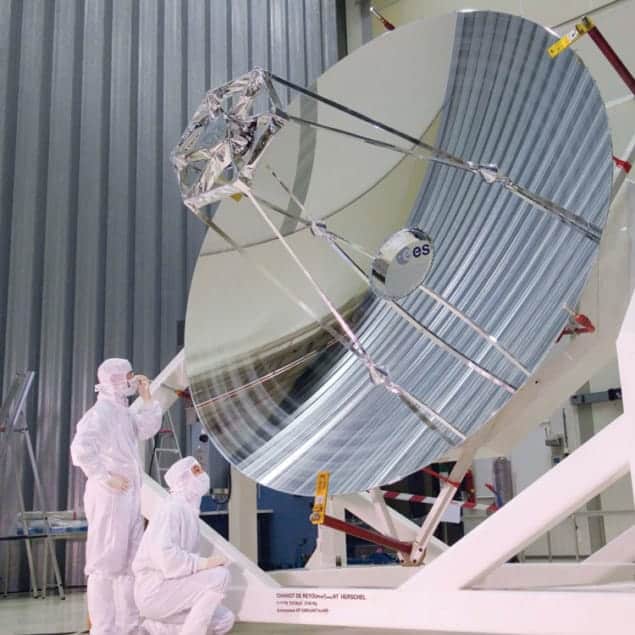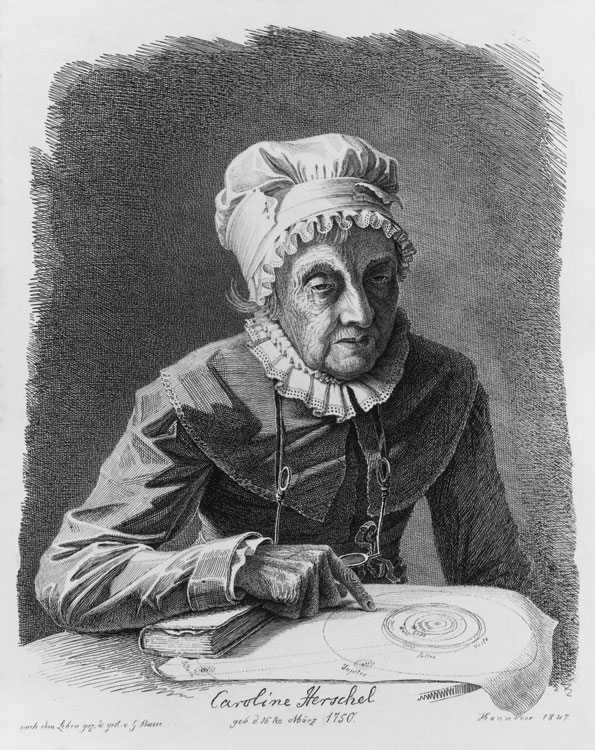Discoverers of the Universe: William and Caroline Herschel
Michael Hoskin
2011 Princeton University Press
£20.95/$29.95hb 272pp

One and a half million kilometres from Earth, a superb observatory is quietly reshaping our understanding of how nebulae coalesce into stars. Its primary instrument is the largest space telescope ever launched, a 3.5 m diameter monster designed for infrared photometry and spectroscopy. This is the Herschel Space Observatory, and over its planned three-year lifetime, this European Space Agency (ESA) mission will study cool objects throughout the universe, including comets, galaxies and nebulae.
The observatory owes its name in part to the astronomer William Herschel, who discovered infrared light (then called “calorific rays”) in 1800. Born in 1738 in Hanover, Germany, Herschel began his career as a musician, and followed his father’s example by joining the band of the Hanoverian Guard. After finding that the military life was not for him, in 1755 he deserted and moved to England. There, his interest in music was gradually eclipsed by another childhood love: astronomy. He would go on to become “the most celebrated of all astronomers of the universe”, according to his contemporary Jérôme de Lalande.
William, however, was not the only Herschel. The ESA observatory is also named for his spinster sister Caroline, who joined him in England in 1772. Initially brought over to work as a housekeeper and general dogsbody, when astronomy took over William’s life, it also took over Caroline’s. After starting as her brother’s assistant, Caroline gradually developed into an observer and astronomer in her own right. In 1786 she became the first woman to discover a comet, and she would go on to discover at least seven (possibly eight) more.
It is fitting, then, that the two Herschels are jointly the subjects of Discoverers of the Universe, a new biography by Michael Hoskin of Churchill College, Cambridge. Hoskin has also written several previous works on the Herschels, and in this book, he discusses not only their science, but also their place in the wider scientific community, the narrower but richer universe of their daily lives, and their sometimes complicated relationship.
During the decade following Caroline’s arrival, William gained a reputation as a skilful astronomer, observing variable stars, measuring the height of lunar mountains and creating a catalogue of double stars. Then, in 1781, he made the discovery that put him firmly among astronomy’s greats. Within months of his finding “a curious either nebulous star or perhaps a comet” in Gemini, it was established that this was a planet beyond Saturn – the first planet to be found since antiquity. In an evening, William had doubled the scale of the solar system. But what should the new world be called? This was before there was an International Astronomical Union to decide such things, so William named it after his king (and fellow Hanoverian), George III. In the rest of the world, though, the prospect of a British monarch being immortalized in the heavens was not greeted with enthusiasm, and by the 1850s even the British had accepted the planet’s alternative name: Uranus, after the Greek god of the sky.
William’s choice did, however, bring him to the king’s attention. Not yet a victim of the mental illness that was to blight his later life, in the 1780s George III was a patron of the sciences, and he had a genuine fascination with astronomy. William was duly appointed “Astronomer to his Majesty”, with a salary of £500 and a residence at Datchet near Windsor (though the house was in such a derelict state that he soon moved to a more comfortable one in Slough). At this, the faithful Caroline abandoned her own interests in a musical career and again joined her brother to act as his housekeeper and assistant.
For the next two decades, the Herschels “swept” the sky, cataloguing nebulae and clusters of stars. This was painstaking and uncomfortable work, especially in the severe winters, and it was all meticulously recorded by Caroline. By 1789 William had a profitable side-line as a manufacturer of telescopes, including an unwieldy “40-foot reflector” that was the largest instrument of its day. Caroline, for her part, at last had her importance officially recognized: the king granted her a salary of £50 to act as her brother’s assistant.
If this book has a hero, it is Caroline. When Hoskin writes about both Herschels, it is with respect for their skill and dedication, but I detect additional warmth when he describes Caroline. It is clear from his account that the Herschels were loving siblings, and Caroline was eternally grateful to William for helping her to escape a grim life of domestic servitude in Hanover. Again and again, though, William followed his own goals at Caroline’s expense, expecting her to abandon any possibility of an independent life to look after his paperwork, painstakingly record and catalogue his (or should that be their) discoveries, ensure his house was well run, and so on. But although she did eventually leave her cottage in the grounds of William’s house, the siblings’ relationship remained cordial, and she was ever ready to assist with his investigations.
Had Caroline remained a drudge in Hanover, the skilful, imaginative and hard-working William would still have been a major figure in astronomy. Caroline’s constant assistance and support, however, made him a giant. In addition to the discoveries already described, over his busy career William found moons of Saturn and Uranus, coined the word “asteroid”, catalogued 3000 variable stars, compared stellar spectra and attempted to confirm that colours travel at different speeds. His observations of star clusters and nebulae (many of which were actually galaxies, a fact unknown to astronomers at the time) suggested that the cosmos evolved with time, providing a nail in the coffin of the notion that we live in a static, completed universe. Herschel’s universe was dynamic, containing objects that went through life cycles, and implying an ancient rather than recent origin of the cosmos. It is not an exaggeration to say that by the time of his death in 1822, William Herschel had turned astronomy into the science that we recognize today.
An important work of biography, Discoverers of the Universe is an enjoyable read, rich in fascinating characters and incidents that reveal not only the human story of two of astronomy’s greats, but also a wider panorama of Georgian science and society. I found it a delight from start to finish.




